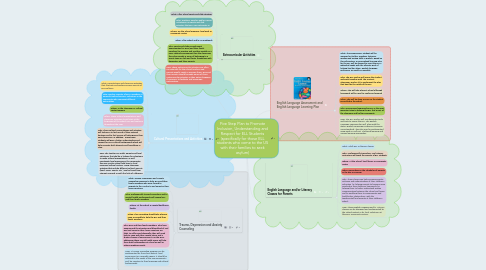Five Step Plan to Promote Inclusion, Understanding and Respect for ELL Students (specifically for those ELL students who come to the US with their families to seek asylum)
by Gwen Norris

1. Trauma, Depression and Anxiety Counseling
1.1. What: Trauma, Depression and Anxiety Counseling program to help ELLs and their family members who were forced to migrate to the US due to civil unrest in their home countries.
1.2. Who: Professionally trained counselors and/or mental health professionals will counsel ELL and their family members
1.3. Where: At the school or mental healthcare facility
1.4. When: This counseling should take place as soon as possible to help the ELL and their family members
1.5. Why: ELLs and their family members who have experienced the atrocities and bloodshed of civil war/civil unrest in their home countries are likely to suffer psychologically; they will need help to cope with their mental stress and a drastic change of environment. For the ELLs, addressing these mental health issues will help them build relationships at school as well as achieve academic goals.
1.6. How: A trauma counseling program can be implemented by the school district, local government or nonprofit agency. It should be adapted to the needs of the new immigrants and be sensitive to their language and cultural backgrounds.
2. Cultural Presentations and Activities
2.1. What: Presentations and classroom activities that illustrate and explain various aspects of ELLs cultures
2.2. Who: Teacher, parents of ELLs, members of nonprofit cultural groups, volunteers in the community who represent different nationalities
2.3. Where: In the classroom or cultural center/museum
2.4. When: These cultural presentations and classroom activities should start at the beginning of the school year and continue throughout the year.
2.5. Why: These cultural presentations and activities will help ELLs to feel proud of their national heritage and to feel a sense of belonging in their new classrooms. In addition, mainstream students will gain a better understanding and respect for ELLs cultural backgrounds which will help promote both diversity and friendships in class.
2.6. How: The teacher can notify parents and local volunteers that she/he is looking for volunteers to make cultural presentations, as well investigate local programs in the community; this may involve school field trips to local museums/cultural centers. Using classroom activities that include different cultural aspects (food, music, sports, etc. ) can be found from Internet research or with the help of a librarian.
3. Extracurricular Activities
3.1. What: After school sports and club activities
3.2. Who: Teachers, Coaches and/or Parent Volunteers run sports and club activities that ELLs can participate in
3.3. Where: On the school premises, local park or community center
3.4. When: After school and/or on weekends
3.5. Why: Sports and clubs provide great opportunities for ELLs (and their family members) to practice and use their English in a more relaxed environment than the classroom; they also provide a sense of belonging to a sports team or club and foster friendships with classmates and their parents.
3.6. How: These extracurricular activities are often run internally by the school; teachers and parents usually coach or oversee them. ELLs and their parents should be made aware of these extracurricular activities in their native language if necessary to facilitate and encourage participation.
4. English Language Assessment and English Language Learning Plan
4.1. What: The incoming ELL student will be assessed on his/her speaking, listening, reading and writing skills in English. Based on this information, a personalized learning plan for the ELL will be devised to meet the ELL's individual needs with the ultimate goal of helping him/her attain English language proficiency as quickly as possible.
4.2. Who: The ELL Teacher will assess the student and work together with the Content Classroom Teacher (s) to implement the plan that best fits the needs of the ELL.
4.3. Where: This will take place at school although homework will be used to reinforce classwork
4.4. When: This will be done as soon as the student is enrolled in the school.
4.5. Why: Overcoming language barriers is the most important step to helping the ELL feel a part of the classroom and his/her community.
4.6. How: The ELL Teacher will use diagnostic tools and tests to assess the ELL. The English Language Learning Plan will align with the state's English Language Proficiency/Common Core standards. This plan may be implemented using push-in, pull-out, sheltered learning and various learning approaches.
5. English Language and/or Literacy Classes for Parents
5.1. What: Adult ESL or literacy classes
5.2. Who:: Professionally trained ELL and Literacy instructors will teach the parents of ELL students
5.3. Where: At the school, local library or community center
5.4. When: Depending on the schedules of parents, in the day or evening
5.5. Why: These classes can help increase parents' inclusion and understanding of their children's education by helping parents to become more involved in their children's homework, by helping them to better understand written communication between the school and home, and by enabling them to communicate and build better relationships with the teachers,staff and parents at their children's school.
5.6. How: These English Language and/or Literacy Classes can be designed and implemented by the School District or by local volunteers at libraries, community centers.


